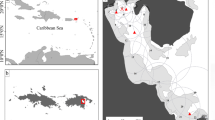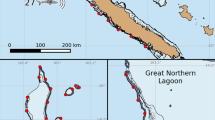Abstract
Comparisons between shark nursery populations are limited, however recent work has shown different populations exhibit distinct space use patterns. This study examined the residency and space use of young of the year (YOY) and juvenile Australian blacktip sharks, Carcharhinus tilstoni in a northern Australian nursery using acoustic telemetry. Presence and space use patterns exhibited by C. tilstoni were highly variable among individuals. In contrast to other shark nursery populations, the majority of YOY individuals left the nursery area within three months of release, while most juveniles exhibited long-term residency (6 months - 1 year). In addition, YOY individuals used smaller amounts of space than juveniles. Variable activity space size and location indicated individuals used different areas and often moved into new areas. High individual variation in juvenile populations is atypical for carcharhinid sharks, and contrasts with other nursery species, including the common blacktip shark C. limbatus, which are known to exhibit residency and consistent space use patterns in nursery areas. The unique patterns observed among C. tilstoni may be due to a number of factors, including differences in nursery habitat and population structure, or strategies to improve survival. This study highlights the importance of investigating nursery behaviour across different habitats and populations.








Similar content being viewed by others
References
Andrews KS, Williams GD, Levin PS (2010) Seasonal and ontogenetic changes in movement patterns of sixgill sharks. PLoS One 5:e12549. doi:10.1371/journal.pone.0012549
Beck MW et al. (2001) The identification, conservation, and management of estuarine and marine nurseries for fish and invertebrates. Bioscience 51:633–641. doi:10.1641/0006-3568(2001)051[0633:ticamo]2.0.co;2
Bowler DE, Benton TG (2005) Cause and consequences of animal dispersal strategies: relating individual behaviour to spatial dynamics. Biol Rev 80:205–225. doi:10.1017/S1464793104006645
Bradshaw CJA, Field IC, McMahon CR, Johnson GJ, Meekan MG, Buckworth RC (2013) More analytical bite in estimating targets for shark harvest. Mar Ecol Prog Ser 488:221–232
Branstetter S (1990) Early life-history implications of selected carcharhinoid and lamnoid sharks of the Northwest Atlantic. NOAA Tech Rep NMFS 90:17–28
Calenge C (2006) The package adehabitat for the R software: a tool for the analysis of space and habitat use by animals. Ecol Model 197:516–519
Castro J (1993) The shark nursery of Bulls Bay, South Carolina, with a review of the shark nurseries of the southeastern coast of the United States. In: LS D, JP W (eds) The reproduction and development of sharks, skates, rays and ratfishes. Developments in environmental biology of fishes, vol 14. Springer, Netherlands, pp. 37–48
Chapman DD et al. (2009) Long-term natal site-fidelity by immature lemon sharks (Negaprion brevirostris) at a subtropical island. Mol Ecol 18:3500–3507. doi:10.1111/j.1365-294X.2009.04289.x
Collins AB, Heupel MR, Motta PJ (2007) Residence and movement patterns of cownose rays Rhinoptera bonasus within a south-West Florida estuary. J Fish Biol 71:1159–1178. doi:10.1111/j.1095-8649.2007.01590.x
Conrath CL, Musick JA (2010) Residency, space use and movement patterns of juvenile sandbar sharks (Carcharhinus plumbeus) within a Virginia summer nursery area. Mar Freshw Res 61:223–235. doi:10.1071/MF09078
Davenport S, Stevens J (1988) Age and growth of two commercially imported sharks (Carcharhinus tilstoni and C. sorrah) from Northern Australia. Mar Freshw Res 39:417–433. doi:10.1071/MF9880417
DeAngelis BM, McCandless CT, Kohler NE, Recksiek CW, Skomal GB (2008) First characterization of shark nursery habitat in the United States Virgin Islands: evidence of habitat partitioning by two shark species. Mar Ecol Prog Ser 358:257–271
Dicken M, Smale M, Booth A (2006) Spatial and seasonal distribution patterns of the ragged-tooth shark Carcharias taurus along the coast of South Africa. Afr J Mar Sci 28:603–616
Froeschke JT, Stunz GW, Sterba-Boatwright B, Wildhaber ML (2010) An empirical test of the ‘shark nursery area concept’in Texas bays using a long-term fisheries-independent data set. Aquat Biol 11:65–76
Grubbs RD (2010) Ontogenetic shifts in movements and habitat use. In: Carrier JC, Musick JA, Heithaus MR (eds) Sharks and their relatives II: biodiversity, adaptive physiology, and conservation. CRC Press, Boca Raton, pp. 319–342
Grubbs RD, Musick JA, Conrath CL, Romine JG (2007) Long-term movements, migration, and temporal delineation of a summer nursery for juvenile sandbar sharks in the Chesapeake Bay region. In: American Fisheries Society symposium, vol 50. American Fisheries Society, p 87
Gruber SH, Nelson DR, Morrissey JF (1988) Patterns of activity and space utilization of lemon sharks, Negaprion brevirostris, in a shallow bahamian lagoon. Bull Mar Sci 43:61–76
Harry AV et al. (2011) Evaluating catch and mitigating risk in a multispecies, tropical, inshore shark fishery within the great barrier reef world heritage area. Mar Freshw Res 62:710–721. doi:10.1071/MF10155
Harry AV, Morgan JAT, Ovenden JR, Tobin AJ, Welch DJ, Simpfendorfer CA (2012) Comparison of the reproductive ecology of two sympatric blacktip sharks (Carcharhinus limbatus and Carcharhinus tilstoni) off North-Eastern Australia with species identification inferred from vertebral counts. J Fish Biol 81:1225–1233. doi:10.1111/j.1095-8649.2012.03400.x
Heithaus MR (2007) Nursery areas as essential shark habitats: a theoretical perspective. In: American Fisheries Society symposium, vol 50. American Fisheries Society, p 3
Heupel MR, Hueter RE (2002) Importance of prey density in relation to the movement patterns of juvenile blacktip sharks (Carcharhinus limbatus) within a coastal nursery area. Mar Freshw Res 53:543–550. doi:10.1071/MF01132
Heupel MR, Simpfendorfer CA (2002) Estimation of mortality of juvenile blacktip sharks, Carcharhinus limbatus, within a nursery area based on telemetry data. Can J Fish Aquat Sci 59:624–632
Heupel MR, Simpfendorfer CA, Hueter RE (2004) Estimation of shark home ranges using passive monitoring techniques. Environ Biol Fish 71:135–142. doi:10.1023/B:EBFI.0000045710.18997.f7
Heupel MR, Simpfendorfer CA, Collins AB, Tyminski JP (2006) Residency and movement patterns of bonnethead sharks, Sphyrna tiburo, in a large Florida estuary. Environ Biol Fish 76:47–67. doi:10.1007/s10641-006-9007-6
Heupel MR, Carlson JK, Simpfendorfer CA (2007) Shark nursery areas: concepts, definition, characterization and assumptions. Mar Ecol Prog Ser 337:287–297. doi:10.3354/meps337287
Heupel MR, Simpfendorfer CA, Olsen EM, Moland E (2012) Consistent movement traits indicative of innate behavior in neonate sharks. J Exp Mar Biol Ecol 432–433:131–137. doi:10.1016/j.jembe.2012.07.013
Hirschfeld M (2013) Habitat use and movement patterns of juvenile and neonate blacktip sharks, Carcharhinus limbatus in nursery areas on San Cristobal Island, Galápagos. Universidad San Francisco De Quito, Quito.
Hussey NE, McCarthy ID, Dudley SFJ, Mann BQ (2009) Nursery grounds, movement patterns and growth rates of dusky sharks, Carcharhinus obscurus: a long-term tag and release study in south African waters. Mar Freshw Res 60:571–583. doi:10.1071/MF08280
Kessel ST et al. (2013) A review of detection range testing in aquatic passive acoustic telemetry studies. Rev Fish Biol Fish:1–20. doi:10.1007/s11160-013-9328-4
Kinney M, Hussey N, Fisk A, Tobin A, Simpfendorfer C (2011) Communal or competitive? stable isotope analysis provides evidence of resource partitioning within a communal shark nursery. Mar Ecol Prog Ser 439:263–276. doi:10.3354/meps09327
Knip DM, Heupel MR, Simpfendorfer CA (2010) Sharks in nearshore environments: models, importance, and consequences. Mar Ecol Prog Ser 402:1–11. doi:10.3354/meps08498
Knip DM, Heupel MR, Simpfendorfer CA, Tobin AJ, Moloney J (2011) Ontogenetic shifts in movement and habitat use of juvenile pigeye sharks Carcharhinus amboinensis in a tropical nearshore region. Mar Ecol Prog Ser 425:233–246. doi:10.3354/meps09006
Knip DM, Heupel MR, Simpfendorfer CA (2012a) Habitat use and spatial segregation of adult spottail sharks Carcharhinus sorrah in tropical nearshore waters. J Fish Biol 80:767–784. doi:10.1111/j.1095-8649.2012.03223.x
Knip DM, Heupel MR, Simpfendorfer CA (2012b) Mortality rates for two shark species occupying a shared coastal environment. Fish Res 125-126:184–189
Last PR, Stevens JD (2009) Sharks and rays of Australia 2nd edn. CSIRO Publishing Collingwood, Victoria
Legare B, Kneebone J, DeAngelis B, Skomal G (2015) The spatiotemporal dynamics of habitat use by blacktip (Carcharhinus limbatus) and lemon (Negaprion brevirostris) sharks in nurseries of St. John, United States Virgin Islands. Mar Biol 162:699–716
Matich P, Heithaus MR (2015) Individual variation in ontogenetic niche shifts in habitat use and movement patterns of a large estuarine predator (Carcharhinus leucas). Oecologia 178:347–359. doi:10.1007/s00442-015-3253-2
McMahon TE, Tash JC (1988) Experimental analysis of the role of emigration in population regulation of desert pupfish. Ecology 69:1871–1883
Morgan JAT et al. (2012) Detection of interspecies hybridisation in chondrichthyes: hybrids and hybrid offspring between Australian (Carcharhinus tilstoni) and common (C. limbatus) blacktip shark found in an Australian fishery. Conserv Genet 13:455–463. doi:10.1007/s10592-011-0298-6
Morrissey JF, Gruber SH (1993) Habitat selection by juvenile lemon sharks, Negaprion brevirostris. Environ Biol Fish 38:311–319. doi:10.1007/bf00007524
Munroe SEM, Simpfendorfer CA, Heupel MR (2014) Habitat and space use of an abundant nearshore shark, Rhizoprionodon taylori. Mar Freshw Res 65:959–968. doi:10.1071/MF13272
Murchie KJ et al. (2010) Spatial ecology of juvenile lemon sharks (Negaprion brevirostris) in tidal creeks and coastal waters of Eleuthera, the Bahamas. Environ Biol Fish 89:95–104. doi:10.1007/s10641-010-9693-y
Näslund I, Milbrink G, Eriksson L, Holmgren S (1993) Importance of habitat productivity differences, competition and predation for the migratory behaviour of Arctic charr. Oikos 66:538–546
Nixon SW, Oviatt CA, Frithsen J, Sullivan B (1986) Nutrients and the productivity of estuarine and coastal marine ecosystems. J Limnol Soc South Africa 12:43–71. doi:10.1080/03779688.1986.9639398
Ovenden JR, Morgan JAT, Kashiwagi T, Broderick D, Salini J (2010) Towards better management of Australia’s shark fishery: genetic analyses reveal unexpected ratios of cryptic blacktip species Carcharhinus tilstoni and C. limbatus. Mar Freshw Res 61:253–262. doi:10.1071/MF09151
Pinheiro J, Bates D, DebRoy S, Sarkar D (2013) nlme: Linear and nonlinear mixed effects models. vol R package version 3.1
Rechisky E, Wetherbee B (2003) Short-term movements of juvenile and neonate sandbar sharks, Carcharhinus plumbeus, on their nursery grounds in Delaware Bay. Environ Biol Fish 68:113–128
Schlaff AM, Heupel MR, Simpfendorfer CA (2014) Influence of environmental factors on shark and ray movement, behaviour and habitat use: a review. Rev Fish Biol Fish:1–15. doi:10.1007/s11160-014-9364-8
Simpfendorfer C, Milward N (1993) Utilisation of a tropical bay as a nursery area by sharks of the families carcharhinidae and sphyrnidae. Environ Biol Fish 37:337–345. doi:10.1007/BF00005200
Simpfendorfer CA, Heupel MR, Hueter RE (2002) Estimation of short-term centers of activity from an array of omnidirectional hydrophones and its use in studying animal movements. Can J Fish Aquat Sci 59:23–32. doi:10.1139/f01-191
Spalding MD et al. (2007) Marine ecoregions of the world: a bioregionalization of coastal and shelf areas. Bioscience 57:573–583. doi:10.1641/b570707
Springer S (1967) Social organization of shark populations. In: Gilbert PW, Mathewson RW, Rall DP (eds) Sharks, skates and rays. John Hopkins Press, Baltimore, pp. 149–174
Taylor MD, Fairfax AV, Suthers IM (2013) The race for space: using acoustic telemetry to understand density-dependent emigration and habitat selection in a released predatory fish. Rev Fish Sci 21:276–285
Wetherbee BM, Gruber SH, Rosa RS (2007) Movement patterns of juvenile lemon sharks Negaprion brevirostris within atol das rocas, Brazil: a nursery characterized by tidal extremes. Mar Ecol Prog Ser 343:283–293
Yates P, Heupel M, Tobin A, Simpfendorfer C (2012) Diversity in young shark habitats provides the potential for portfolio effects. Mar Ecol Prog Ser 458:269–281. doi:10.3354/meps09759
Yates PM, Heupel MR, Tobin AJ, Moore SK, Simpfendorfer CA (2015) Diversity in immature-shark communities along a tropical coastline. Mar Freshw Res 66:399–410
Acknowledgments
We thank all the staff and students at the Centre for Sustainable Tropical Fisheries and Aquaculture including Merritt Adkins, Fernanda de Faria, Mario Espinoza, Madeline Green, Lauren Meyer, Jonathan Smart, and countless volunteers for their help and support of this project. We would also like to thank Vinay Udaywer for field and statistical assistance. Primary financial support came from the National Environmental Research Program awarded to MRH and CAS. All research was conducted in accordance with James Cook University (JCU) animal ethics permit A1566 and Great Barrier Reef (G11/346181.1) and QDAF (144482) permits for animal collection.
Author information
Authors and Affiliations
Corresponding author
Rights and permissions
About this article
Cite this article
Munroe, S.E.M., Simpfendorfer, C.A. & Heupel, M.R. Variation in blacktip shark movement patterns in a tropical coastal bay. Environ Biol Fish 99, 377–389 (2016). https://doi.org/10.1007/s10641-016-0480-2
Received:
Accepted:
Published:
Issue Date:
DOI: https://doi.org/10.1007/s10641-016-0480-2




